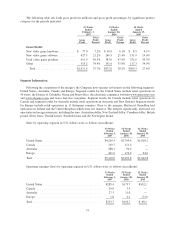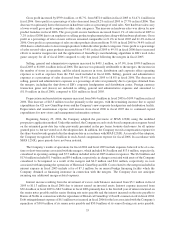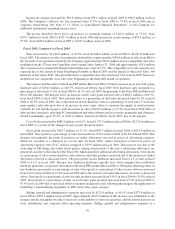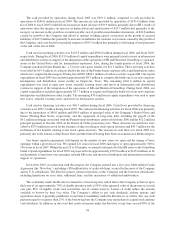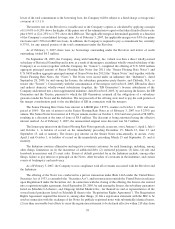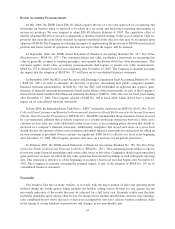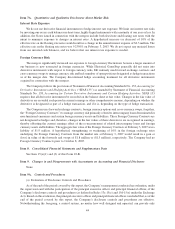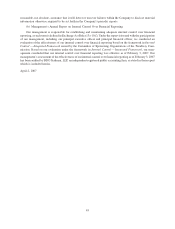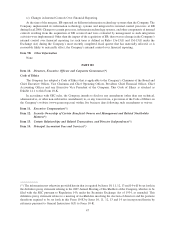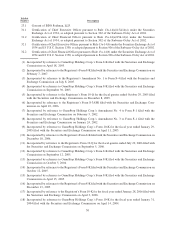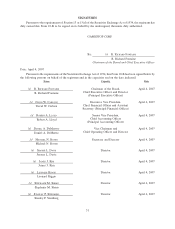GameStop 2006 Annual Report Download - page 58
Download and view the complete annual report
Please find page 58 of the 2006 GameStop annual report below. You can navigate through the pages in the report by either clicking on the pages listed below, or by using the keyword search tool below to find specific information within the annual report.Recent Accounting Pronouncements
In July 2006, the FASB issued FIN 48, which requires the use of a two-step approach for recognizing and
measuring tax benefits taken or expected to be taken in a tax return and disclosures regarding uncertainties in
income tax positions. We were required to adopt FIN 48 effective February 4, 2007. The cumulative effect of
initially adopting FIN 48 is to record an adjustment to opening retained earnings in the year of adoption. Only tax
positions that meet the more likely than not recognition threshold at the effective date may be recognized upon
adoption of FIN 48. The Company is evaluating the impact of implementing the provisions of FIN 48 on its financial
position and future results of operations, but does not expect that the impact will be material.
In September 2006, the FASB issued Statement of Financial Accounting Standard No. 157, Fair Value
Measurements (“SFAS No. 157”). This statement defines fair value, establishes a framework for measuring fair
value in generally accepted accounting principles, and expands disclosures about fair value measurements. This
statement applies under other accounting pronouncements that require or permit fair value measurements.
SFAS No. 157 is effective for fiscal years beginning after November 15, 2007. The Company is currently assessing
the impact that the adoption of SFAS No. 157 will have on its consolidated financial statements.
In September 2006, the SEC issued Securities and Exchange Commission Staff Accounting Bulletin No. 108
(“SAB No. 108”) in order to eliminate the diversity of practice surrounding how public companies quantify
financial statement misstatements. In SAB No. 108, the SEC staff established an approach that requires quan-
tification of financial statement misstatements based on the effects of the misstatements on each of the Company’s
financial statements and the related financial statement disclosures. SAB No. 108 is effective for fiscal years ending
after November 15, 2006. The Company adopted of SAB No. 108 in fiscal 2006, which did not have a material
impact on its consolidated financial statements.
In June 2006, the Emerging Issues Task Force (“EITF”) ratified its conclusion on EITF No. 06-03, How Taxes
Collected From Customers and Remitted to Governmental Authorities Should Be Presented in the Income Statement
(That Is, Gross Versus Net Presentation)(“EITF 06-03”). The EITF concluded that the presentation of taxes assessed
by a governmental authority that is directly imposed on a revenue-producing transaction between a seller and a
customer such as sales, use, value added and certain excise taxes, is an accounting policy decision that should be
disclosed in a company’s financial statements. Additionally, companies that record such taxes on a gross basis
should disclose the amounts of those taxes in interim and annual financial statements for each period for which an
income statement is presented if those amounts are significant. EITF 06-03 is effective for fiscal years beginning
after December 15, 2006. The Company presents such taxes on a net basis for all periods presented.
In February 2007, the FASB issued Statement of Financial Accounting Standard No. 159, The Fair Value
Option for Financial Assets and Financial Liabilities (“SFAS No. 159”). This statement permits entities to choose
to measure many financial instruments and certain other items at fair value. Companies should report unrealized
gains and losses on items for which the fair value option has been elected in earnings at each subsequent reporting
date. This statement is effective as of the beginning of an entity’s first fiscal year that begins after November 15,
2007. The Company is currently assessing the potential impact, if any, of the adoption of SFAS No. 159 on its
consolidated financial statements.
Seasonality
Our business, like that of many retailers, is seasonal, with the major portion of sales and operating profit
realized during the fourth quarter which includes the holiday selling season. Results for any quarter are not
necessarily indicative of the results that may be achieved for a full fiscal year. Quarterly results may fluctuate
materially depending upon, among other factors, the timing of new product introductions and new store openings,
sales contributed by new stores, increases or decreases in comparable store sales, adverse weather conditions, shifts
in the timing of certain holidays or promotions and changes in our merchandise mix.
43


